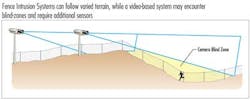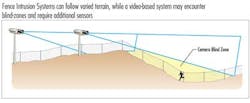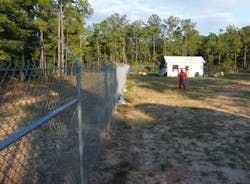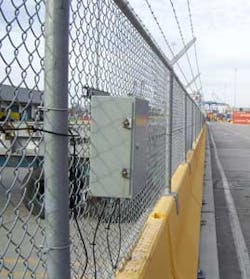Combining Sensors for More Efficient Perimeter Protection
Protecting water facilities and their resources is critical for water and wastewater security professionals. It is the security professional's job to have a system in place to manage perimeter intrusions in an effective manner, within the constraints of a limited budget.
Fence intrusion systems and camera-enabled video analytics systems are two popular forms of perimeter protection for water facilities. Historically, facilities have often chosen either a fence system or an intelligent camera system to provide their primary perimeter protection. In many cases the choice of one or the other may be limiting; combining these systems can result in a more efficient and effective perimeter solution.
Fence Intrusion Systems
Fence Intrusion Detection Systems (FIDS) fall into a category of sensors that provide a linear protection perfect for following a defined perimeter. The systems range greatly in style and technology. The most popular systems in today's market are the ones that measure a disturbance of the fence electrically over a coax or fiber and then analyze and report relative information about that disturbance, including location and size. They also have the ability to tune out typical nuisance events like wind or vibrations from nearby roads. In many cases, these products mount physically to a fence or may be buried along the perimeter.
Fence-based intrusion systems have several advantages that make them attractive for perimeter protection. One of these is their immunity to weather. With the exception of very deep accumulating snow, fence systems continue to detect in rain, fog, snow and wind. These systems have been deployed in a vast array of climates and continue to perform as intended.
A condition that is often overlooked, or perhaps "under budgeted," is detection capabilities in low light conditions. This type of system shines in these situations, as they require no illumination to detect.
Finally, they adapt well to varied terrain and jagged perimeters. Since these systems attach to the fence, or follow its base, the varied direction and elevation has no impact on detection capabilities.
Video Analytics
The use of intelligent imaging sensors is also a widely popular and effective perimeter protection choice. Intelligent cameras come in many forms, analytics may be embedded in the camera, in a nearby edge-device or it may reside as a software function in a DVR/NVR.
Video Analytics or Video Content Analysis (VCA) goes well beyond motion detection. Most systems provide a much higher level of detection, discrimination and identification. These systems analyze image pixels to understand what constitutes the scene and what is considered an object of interest.
An advantage of VCA systems is the ability to actually see the object of interest. Studies show that vision is the dominant sense for humans. When placed in conflict with other senses, humans will overwhelmingly select and accept the decision that favors a visual input. The visual aspect of VCA solutions, including set up, detection and notification all plays to our comfort as humans to base decisions on visual data.
Another advantage is the vast amount of information that can be collected. Video has many dimensions, many of which can be used in detecting and reporting. This includes things like distance, proximity, color, time, texture and contrast. This allows video analytics systems to be very specific in their alarming and the reported alarm data. Setting a VCA alarm to detect "large trucks entering an area traveling at excessive speeds during working hours" is easily accommodated.
Complementary Sensors
Although both Fence Intrusion Detection and Video Analytics are excellent choices for perimeter protection, using them together provides for a very complementary solution.
One of the most obvious benefits is performance in challenging weather conditions. Video systems must be able to "see" the intrusion. In cases where this is not possible, the system cannot provide alarms as it is not receiving images. On the other hand, the fence system can continue to detect irrespective of the weather.
A similar benefit comes in challenging lighting scenarios. A typical video system cannot perform without adequate illumination. The exception is a thermal based system, but this is often beyond the budget of a water facility. Cameras are making vast leaps in video quality, but they can still suffer from limited dynamic range. The easy way to think of this is the ability to see an intruder lurking in a shadow on a very bright day. Another scenario occurs when the sun is shining directly into the lens. Much like a driver trying to read a street sign when the sun is in their eyes, this can be challenging for cameras and video analytics.
Fence systems are very linear in nature and discrete in their alarm capabilities. It does not have a predictive nature, nor does it afford a post mortem analysis. Video Analytics offer a region-based sensor. This affords the ability to create many zones of interest and look for predictive actions such as loitering, speed or class of vehicle. Likewise, adding a video based component helps to provide the "how." For future prevention it may be nice to know how the fence was breached. A video based component can complement a fence system with this type of predictive and post-mortem analysis.
It is often easier for a water facility to obtain funds for a non-recurring purchase versus asking for an increase in yearly operating budget. The combination of a Fence System and Video Analytics system can help minimize those recurring costs.
Firstly, water facilities often have the need for expansion or have situations where the fence line may temporarily change for a short, or extended, period of time. In these cases, moving a fence intrusion system will result in increased operating cost. However, if a complementary VCA component was available, it could provide temporary monitoring for this new fence line with merely a setup change in the software.
Another "recurring cost" that can be mitigated by combining sensors is the ability to efficiently respond to the perimeter system. Water facilities site locations are often separated by many miles. Some locations may be unmanned. The combination of fence and video sensor technology can decrease the recurring cost of validating alarms by not requiring a human to drive to the location. Video analytics can validate the fence alarm, automatically follow the intruder with a PTZ camera and provide video alarm information. The security professional now has cost saving options. When the system alarms due to kids jumping the fence, but doing no damage, the flexibility to verify the event and track it, may save valuable time and fuel costs by not needing to react immediately.
Typical Architecture
Architectures to capitalize on the advantages of combining fence sensors and video analytics vary based on sites and potential threats. However, the basics remain the same. Typically fence sensors are used to protect long stretches of perimeter, or areas of varied terrain (hills, staggered perimeter). PTZ cameras are then used to cover these segments of fence, allowing the ability to verify fence alarms and auto follow intrusions. Scene cameras are added to specific areas to provide short or long term flexibility in the perimeter, predictive coverage and ability to perform forensic actions.
More WaterWorld Current Issue Articles
More WaterWorld Archives Issue Articles



